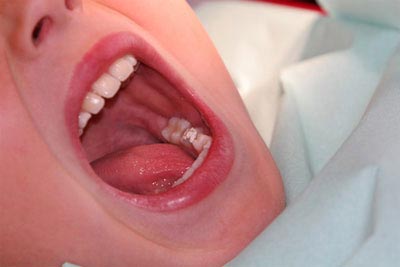A cold is the most common childhood illness. There are many schools of thought surrounding cold treatments. Read about some of the myths associated with treating a cold. Sniffles and a runny nose are synonymous with children, especially those below 5 years. The common cold is not dangerous in any way and a cold virus cannot affect an individual more than once. Unfortunately, there are more than two thousand cold viruses in the environment that can strike a person. Children are most susceptible to catching a cold. The average infant can have a cold up to six times in a year. Treatments for a cold are numerous, depending on the severity of your childs symptoms and what methods you know about. There are many schools of thought surrounding cold treatments. Find out if they are scientifically acceptable. In this articleColoured mucous implies a bacterial infectionChilly weather leads to a coldFeed a cold and starve a feverMilk aggravates a cold Coloured mucous implies a bacterial infection The snot or nasal discharge from your childs nose is not an accurate way to diagnose if your child has a bacterial infection. When your child has a cold, his immune system fights against it. The nasal discharge is nothing but the antibodies and germ cells that have been destroyed in the fight, which have to be thrown out of the body. Your child will display the same response irrespective of whether his cold is resulting from a bacteria or virus. Nasal discharge can provide clues to the severity of the infection. If the nasal discharge becomes thicker, the infection may require medical attention. Similarly, if you notice discharge from your childs eyes, it could be a symptom of an ear infection in addition to a cold. Chilly weather leads to a cold There is no connection between cold weather and your child getting a cold. A cold is a viral infection and the cold viruses are no different from those that cause other diseases. So how does your child catch a cold? The answer is simple. When a person who already has a cold coughs or sneezes, the germs are released into the air as part of mucous droplets. These droplets may be inhaled by your child, leading to infection. Alternatively, colds can be transferred by direct contact. This would occur if your child touched a mucous-laden surface and then put his fingers into his nose or mouth. Upon entry into the body, the virus undergoes an incubation period of a few days before actually manifesting itself as a cold. Feed a cold and starve a fever Depending on the intensity of the virus attacking your child, a cold may be accompanied by a low-grade fever. At this time, it is perfectly normal for your child to lose his appetite. While you should not force your child to eat if he does not want to, keeping your child well hydrated is an important part of helping his immune system fight the virus. If your child does not replenish the fluids his body is losing, he may become dehydrated. This may lead to inflammation of the nasal passages because of inadequate lubrication. In addition, themucous being expelled from the body will become thicker and block the nostrils, leading to breathing problems for your child. To make it easier for your child to feed, try suctioning his nose before each meal. For an infant, gentle aspiration with a pump is recommended. For an older child, minimise the amount of solid food to consume by giving him mashed and pureed fruits and vegetables. Milk aggravates a cold This statement is only partially true. Milk does affect mucous production but this is only if a child is already lactose intolerant. The general symptoms of lactose intolerance include watery eyes, wheezing, and a runny nose, which are similar to the effects of a cold. If the child consumes milk while battling a cold virus, the allergic reaction results in increased mucous production. On the other hand, a child not allergic to milk will not feel any additional ill effects. In this case, milk is beneficial as it replenishes the liquids lost from the body.
A cold is the most common childhood illness. There are many schools of thought surrounding cold treatments. Read about some of the myths associated with treating a cold. Sniffles and a runny nose are synonymous with children, especially those below 5 years. The
common cold is not dangerous in any way and a cold virus cannot affect an individual more than once. Unfortunately, there are more than two thousand cold viruses in the environment that can strike a person. Children are most susceptible to catching a cold. The average infant can have a cold up to six times in a year.
Treatments for a cold are numerous, depending on the severity of your child's symptoms and what methods you know about. There are many schools of thought surrounding
cold treatments. Find out if they are scientifically acceptable.
Coloured mucous implies a bacterial infection
The snot or nasal discharge from your child's nose is not an accurate way to diagnose if your child has a bacterial infection. When your child has a cold, his
immune system fights against it. The nasal discharge is nothing but the antibodies and germ cells that have been destroyed in the fight, which have to be thrown out of the body. Your child will display the same response irrespective of whether his cold is resulting from a bacteria or virus.
Nasal discharge can provide clues to the severity of the infection. If the nasal discharge becomes thicker, the infection may require medical attention. Similarly, if you notice discharge from your child's eyes, it could be a symptom of an ear infection in addition to a cold.
Chilly weather leads to a cold
There is no connection between cold weather and your child getting a cold. A cold is a
viral infection and the cold viruses are no different from those that cause other diseases. So how does your child catch a cold? The answer is simple. When a person who already has a
cold coughs or sneezes, the germs are released into the air as part of mucous droplets. These droplets may be inhaled by your child, leading to infection.
Alternatively, colds can be transferred by direct contact. This would occur if your child touched a mucous-laden surface and then put his fingers into his nose or mouth. Upon entry into the body, the virus undergoes an incubation period of a few days before actually manifesting itself as a cold.
Feed a cold and starve a fever
Depending on the intensity of the virus attacking your child, a cold may be accompanied by a low-grade
fever. At this time, it is perfectly normal for your child to lose his appetite. While you should not force your child to eat if he does not want to, keeping your child well hydrated is an important part of helping his immune system fight the virus.
If your child does not replenish the fluids his body is losing, he may become dehydrated. This may lead to inflammation of the nasal passages because of inadequate lubrication. In addition, themucous being expelled from the body will become thicker and block the nostrils, leading to breathing problems for your child. To make it easier for your child to feed, try suctioning his nose before each meal. For an infant, gentle aspiration with a pump is recommended. For an older child, minimise the amount of solid food to consume by giving him mashed and pureed fruits and vegetables.
Milk aggravates a cold
This statement is only partially true. Milk does affect mucous production but this is only if a child is already lactose intolerant. The general symptoms of lactose intolerance include watery eyes, wheezing, and a runny nose, which are similar to the effects of a cold. If the child consumes milk while battling a cold virus, the allergic reaction results in increased mucous production. On the other hand, a child not allergic to milk will not feel any additional ill effects. In this case, milk is beneficial as it replenishes the liquids lost from the body.

































